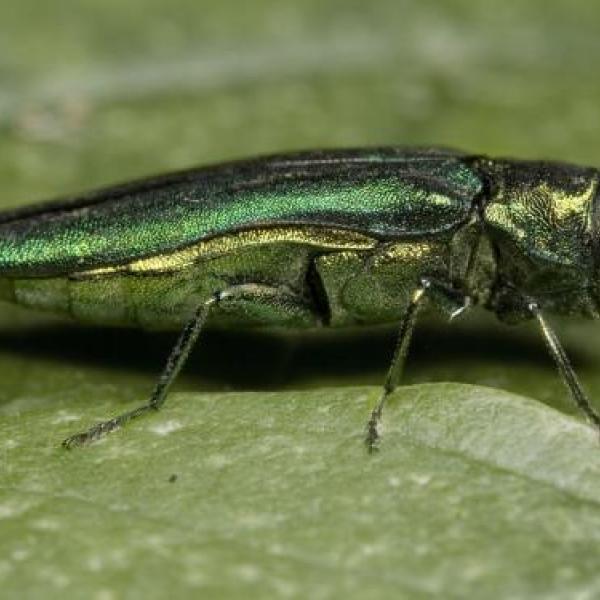
News Source
The emerald ash borer is poised for an assault on Nebraska’s ash trees, but the best thing that homeowners can do is wait.
That’s the advice from landscape experts, who say treatment methods that ward off the destructive pest also are hard on trees.
Waiting until the beetle is discovered within 15 miles is considered best for your tree and your pocketbook, said Mark Harrell, forest health program leader for the Nebraska Forest Service. That’s because other states have found little spread beyond 15 miles at a time, while treatment is costly and can harm the environment.
Beyond 15 miles, “the chance of having the insect in your tree is so low, it’s almost zero,” Harrell said.
The impulse to do something is understandable: The borer is the most destructive infestation of U.S. trees on record, and it’s known to be within 100 miles of Omaha — in Creston, Iowa.
Nebraska homeowners have begun lighting up phone lines asking what to do about their ash trees. The good news is that treatment methods are now considered effective. When the invasive pest was first discovered in the United States in 2002, tree experts believed there was no hope.
Agricultural insecticides containing imidacloprid, dinotefuran or emamectin benzoate now are commonly used against the borer, Harrell said. Some require professional expertise, and some can be done by homeowners. The two general methods are injections and treating the ground around the tree.
Treatment costs range from $30 a year to $100 a year, depending on the type of chemical used and whether a professional treats the tree, said Eric Berg, community forester for the Nebraska Forest Service. Treatment by a professional has a higher rate of effectiveness and involves chemicals with less potential to harm the broader environment, he said.
Kathleen Cue, horticulturist with the University of Nebraska-Lincoln Extension in Douglas and Sarpy Counties, offers a practical reason to wait. Treatment can weaken the tree, so it’s better to wait until the threat is real.
“You’re using up some of the plant’s reserves when you treat it,” Cue said. “The idea is to keep your tree as healthy as possible so that when the emerald ash borer gets here, the tree is healthy, and you can help it.”
Harrell said the forest service plans to map beetle infestation in Nebraska so homeowners will know how close it is getting to their property. By itself, the insect isn’t able to fly even a mile, he said. Instead, transport within a community typically occurs when it hitches a ride on a vehicle.
Harrell and Berg said the two methods used to treat trees carry different downsides.
Direct injection into the trunk is more effective, but the bore holes in the tree provide a path past the tree’s defenses for disease and insects, they said. Ground treatment, which is what homeowners would use, increases the potential for larger environmental harm, both to the area immediately around the tree and farther out as a result of runoff. That’s because the treatment can kill organisms needed to create healthy soil.
Also, some insecticides are so potent that their per-acre use must be limited. This will mean that there will be instances in which not all trees in a neighborhood, or even yard, can receive the same treatment, so choices will have to be made if treatment is to be done responsibly.
Finally, Berg said, there’s the question of money, both in terms of scams as well as long-term legitimate costs.
Treatment is required for the life of the tree, so people need to evaluate their trees to be sure they’re worth saving. Nebraska’s trees have been stressed by drought and extreme weather, so even native ash trees have lost their vigor.
To find out if a tree is worth saving and to get a good cost estimate for making that decision, Berg recommends asking a certified arborist to evaluate your tree.
As a rule of thumb, trees that are 12 to 30 inches in diameter are generally considered candidates for saving, Berg said. Smaller trees are so young that you’re better off starting over and planting a new tree. Larger trees have matured and are beginning to decline.
Berg said other criteria come into play, too. Perhaps a tree is beloved or critical to your property values or reducing your energy bills. Those are legitimate reasons for saving a tree, he said.
Berg said foresters have already heard of potential scammers working Omaha neighborhoods door to door saying people need to begin treating their ash trees now.
Berg also is concerned that people may incorrectly believe that because cities are planning to treat trees, they also should do so. The primary reason local governments will treat trees is the need to spread out costs. Cities have to keep some trees alive longer than others so city budgets don’t get overwhelmed by the costs of cutting down a sudden glut of dead trees.
Within the first few years after a confirmed discovery, widespread tree deaths aren’t a problem. But once the beetle is established, the death rate skyrockets. Once the borer kills a tree, a fungus that follows renders the tree brittle within about two years, Berg said.
The emerald ash borer is considered fatal to North American ash trees because the beetle is an import and trees on this continent have no natural defenses against it.
In any case, Berg and other foresters are hoping that people will consider planting a young tree now so it can replace those that will be lost to the emerald ash borer.
When deciding which type of tree to plant, foresters hope that people will select a type that thrives in this region and is a long-lived shade tree.